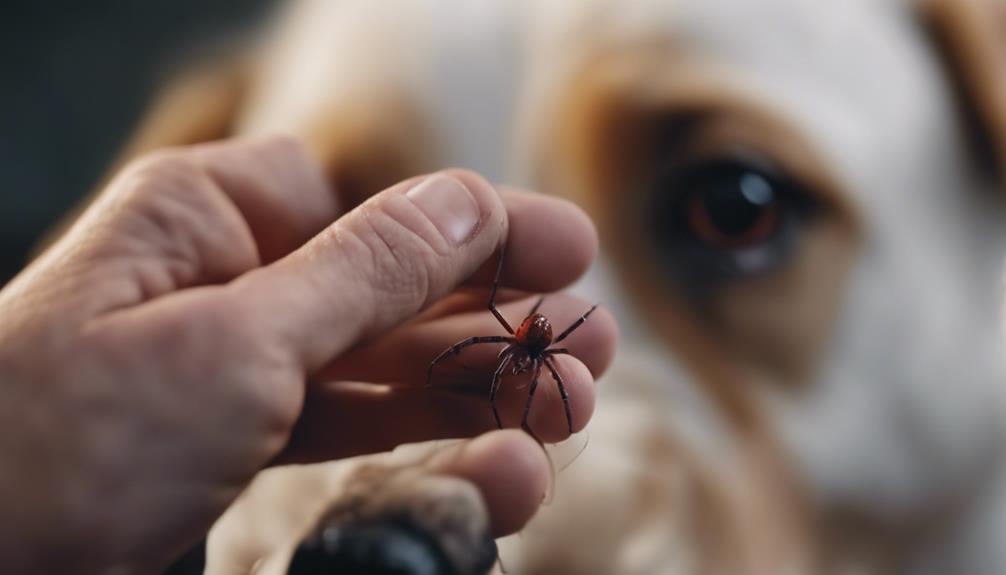When it comes to the well-being of our canine companions, detecting a potential spider bite can be a cause for concern. The telltale signs may not always be obvious, requiring a keen eye and swift action. Understanding the steps to take upon suspecting a spider bite on your dog is crucial to ensuring their health and comfort.
In this article, we will explore the nuanced approach to handling such situations, providing insights into identification, symptoms, and appropriate responses. Stay tuned for expert advice on navigating the complexities of spider bites on dogs and safeguarding your pet's welfare.
Key Takeaways
- Spider bites on dogs can appear as pink or red bumps, sometimes resembling other insect bites.
- Look out for symptoms like hives, facial swelling, muscle pain, and skin discoloration from venomous spider bites.
- Seek veterinary care if you suspect a venomous spider bite to prevent severe effects or tissue damage.
- Treat spider bites by cleaning the area, using oatmeal shampoo for irritation, and avoiding ice to prevent worsening.
Recognizing Spider Bites on Dogs
When observing potential spider bites on dogs, one may notice distinct pink or red bumps that could indicate spider venom exposure. These bumps may be accompanied by localized swelling and tenderness at the bite site.
It is essential to differentiate spider bites from other insect bites as some venomous spiders, like the brown recluse, can cause tissue damage and skin cell death. Additionally, spider bites may present as changing color lesions, which could progress to more severe symptoms over time.
Owners should carefully monitor these bumps for any signs of allergic reactions or worsening conditions. Seeking prompt veterinary care is crucial to properly diagnose and treat spider bites in dogs, especially those caused by venomous spiders like the brown recluse or black widow.
Identifying Allergic Reactions in Dogs
Allergic reactions in dogs to spider bites can manifest as hives, facial swelling, or other dermatological symptoms. These reactions occur due to the dog's immune system overreacting to the spider's venom.
In addition to hives and swelling, dogs may exhibit symptoms such as itching, redness, and inflammation at the bite site. It is essential to monitor your dog closely for any signs of allergic reactions following a spider bite.
If you notice any of these symptoms, it is advisable to seek veterinary attention promptly. A veterinarian can provide appropriate treatment, which may include antihistamines, corticosteroids, or other medications to alleviate the allergic response and prevent further complications.
Understanding Venomous Spider Bites

Understanding the implications of venomous spider bites on dogs is crucial for prompt identification and appropriate intervention to mitigate potential health risks. Venomous spider bites can have serious consequences for dogs, so being able to recognize the signs and symptoms is essential.
Here are key points to consider:
- Promptly identify the type of spider responsible for the bite.
- Monitor for signs of tissue damage or skin discoloration.
- Seek immediate veterinary care if a venomous spider bite is suspected.
- Do not attempt home remedies without professional guidance.
Symptoms of Spider Bites in Dogs
Detection of spider bites on dogs can be challenging due to their fur coverage, making it crucial to be vigilant for subtle symptoms that may indicate a potential bite. Symptoms of spider bites in dogs can vary depending on the type of spider and the dog's reaction to the venom. Common symptoms of venomous spider bites in dogs include red or pink bumps, hives, facial swelling, and changing color lesions.
Venomous spider bites, such as those from black widows and brown recluses, can lead to more severe symptoms like muscle pain, paralysis, tremors, tissue damage, and skin discoloration. It is important to monitor your dog closely for any unusual symptoms and seek veterinary care promptly if you suspect a spider bite.
Dealing With Brown Recluse Bites

When addressing the treatment of spider bites on dogs, a particular focus should be given to the management of brown recluse bites due to their potential for causing significant tissue damage and skin cell death. Brown recluse spider bites in dogs can be particularly concerning due to the following reasons:
- Painful symptoms such as redness, swelling, and tissue necrosis.
- Changes in the color of the bite site from pink to dark red or black.
- Presence of blisters, vomiting, and lethargy.
- Tissue damage that spreads outward from the initial bite location.
It is crucial to seek veterinary care promptly if a brown recluse spider bite is suspected in a dog to prevent further complications and provide appropriate treatment.
Managing Black Widow Bites
When addressing the management of black widow spider bites in dogs, it is crucial to promptly identify and address any potential symptoms to prevent severe complications. Black widow bites can induce muscle pain, paralysis, and tremors in dogs.
The injection of neurotoxins by black widows can lead to severe effects, and signs like drooling, vomiting, and diarrhea may indicate a black widow bite. If left untreated, black widow bites can be fatal for dogs.
Immediate veterinary care is essential in suspected black widow bite cases. Veterinarians may administer anti-venom if necessary and provide supportive care to manage the symptoms effectively and increase the chances of a successful recovery.
Initial Actions for Spider Bites

When managing spider bites on dogs, swift identification and appropriate initial actions are critical to addressing potential complications effectively. It is important to act promptly to minimize the impact of the bite on your dog's health.
Here are some initial actions to take:
- Inspect the Bite Area: Check the affected area for signs of a bite mark or unusual swelling.
- Clean the Wound: Use mild soap and water to clean the area if a bite mark is visible.
- Monitor for Symptoms: Keep an eye out for any signs of allergic reactions or venomous spider bites.
- Seek Veterinary Care: If you suspect a venomous spider bite or notice concerning symptoms, seek immediate veterinary attention for proper diagnosis and treatment.
Home Remedies for Spider Bites
What are some effective home remedies for treating spider bites on dogs?
Home remedies can help alleviate discomfort from spider bites on dogs. Applying a cold compress to the affected area can reduce swelling and pain. A mixture of baking soda and water applied as a paste can help soothe itching and irritation caused by spider bites. Aloe vera gel can also provide relief and promote healing of the skin. Additionally, giving your dog an oatmeal bath can help reduce inflammation and itching.
These home remedies can be beneficial for managing mild spider bites on dogs, but it's essential to monitor for any signs of infection or worsening symptoms and seek veterinary care if needed.
Seeking Veterinary Care

In cases where home remedies do not sufficiently alleviate symptoms of spider bites on dogs, prompt veterinary care should be sought to ensure proper assessment and treatment. Seeking veterinary care is crucial to address potential complications and provide appropriate medical interventions.
When considering veterinary assistance for spider bites on dogs, follow these essential steps:
- Schedule an urgent appointment with a veterinarian specializing in dermatology or toxicology.
- Be prepared to provide details about the spider bite incident, symptoms observed, and any previous treatments administered.
- Allow the veterinarian to conduct a thorough physical examination to assess the bite site and determine the best course of action.
- Follow the veterinarian's recommendations for treatment, which may include medication, wound care, or monitoring for any adverse reactions.
Conclusion
In conclusion, recognizing and understanding spider bites on dogs is essential for pet owners to ensure prompt and appropriate treatment.
By being vigilant and knowledgeable about the symptoms and management of spider bites, pet owners can protect their furry companions from potential harm.
Seeking veterinary care and following proper protocols are crucial steps in safeguarding canine well-being when faced with suspected spider bites.
Stay informed and proactive to ensure the continued health and comfort of your beloved pets.




